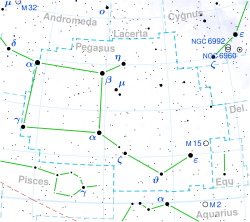| Observation data Epoch J2000 Equinox J2000 | |
|---|---|
| Constellation | Pegasus [1] |
| Right ascension | 22h 03m 10.77275s [2] |
| Declination | +18° 53′ 03.5494″ [2] |
| Apparent magnitude (V) | 7.65 [1] |
| Characteristics | |
| Evolutionary stage | main sequence [2] |
| Spectral type | F9 V [3] or G0 V [4] |
| Apparent magnitude (B) | 8.244 [1] |
| Apparent magnitude (K) | 6.308±0.026 [1] |
| B−V color index | +0.574±0.014 [5] |
| Variable type | EP [6] |
| Astrometry | |
| Radial velocity (Rv) | −14.78±0.16 [2] km/s |
| Proper motion (μ) | RA: 29.766(28) mas/yr [2] Dec.: −17.976(25) mas/yr [2] |
| Parallax (π) | 20.7694±0.0266 mas [2] |
| Distance | 157.0 ± 0.2 ly (48.15 ± 0.06 pc) |
| Absolute magnitude (MV) | 4.28±0.10 [5] |
| Details | |
| Mass | 1.148±0.022 [7] M☉ |
| Radius | 1.203±0.061 [7] R☉ |
| Luminosity | 1.77±0.14 [7] L☉ |
| Surface gravity (log g) | 4.38 [7] cgs |
| Temperature | 6,071±20 [7] K |
| Metallicity [Fe/H] | 0.00±0.02 [5] dex |
| Rotation | 10.65±0.75 d [8] |
| Rotational velocity (v sin i) | 4.49±0.50 [8] km/s |
| Age | 3.5±1.4 [7] Gyr |
| Other designations | |
| V376 Peg, BD+18°4917, HIP 108859, SAO 107623, 2MASS J22031077+1853036 [9] | |
| Database references | |
| SIMBAD | data |
| Exoplanet Archive | data |
HD 209458 is a star with an orbiting exoplanet in the constellation Pegasus. It has an apparent visual magnitude of 7.65 [1] and an absolute magnitude of 4.28. [5] Because it is located at a distance of 157 light-years (48 parsecs ) from the Sun as measured via parallax, it is not visible to the unaided eye. With good binoculars or a small telescope it should be easily detectable. The system is drifting closer with a heliocentric radial velocity of −14.8 km/s. [2]


